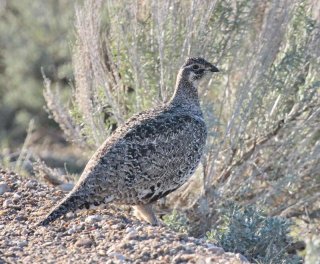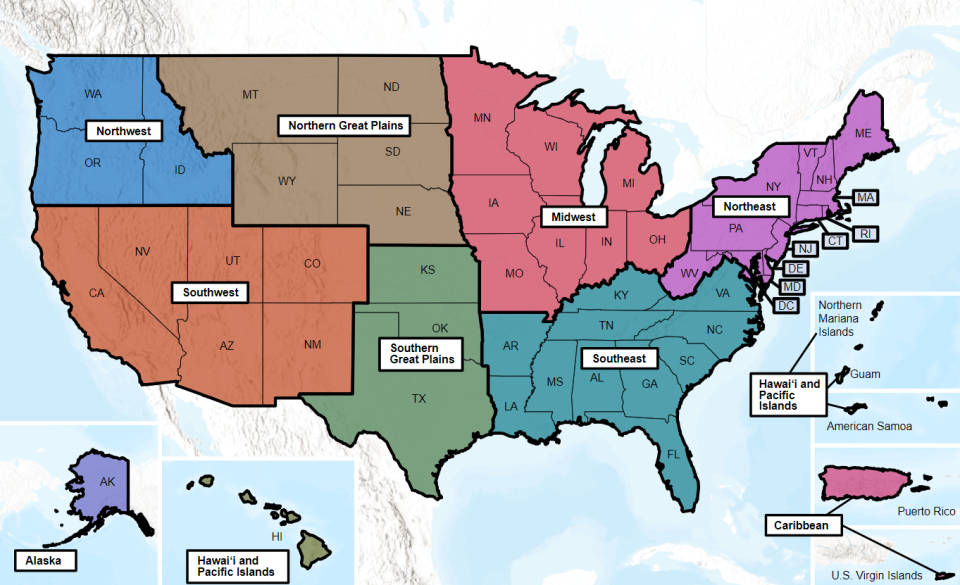Climate Change Connections: Utah (Sagebrush Ecosystems)
Climate change is impacting all regions and sectors of the United States. The State and Regional Climate Change Connections resource highlights climate change connections to culturally, ecologically, or economically important features of each state and territory. The content on this page provides an illustrative example. As climate change will affect each state and territory in diverse ways, this resource only describes a small portion of these risks. For more comprehensive information about regional climate impacts, please visit the Fifth National Climate Assessment and Climate Change Impacts by Sector.
On this page:
Introduction: Sagebrush—A Small Plant with a Big Reach

Sagebrush is a small, woody shrub with gray-green leaves. This shrub plays a major role in the American West, providing numerous cultural, ecological, and economic benefits. Covering nearly one-third of the lower 48 states, the American sagebrush steppe is the largest contiguous ecotype (distinct group that is genetically adapted to a particular habitat) in the country.1 Sagebrush can be found in many parks and scenic areas across Utah and plays an integral role in ecosystems across the state and region.

Sagebrush prefers dry, sandy, or rocky soil, and it is well adapted to withstand periods of drought and fluctuating temperatures.2 Deep-rooted and hardy desert grasses, called bunchgrasses, often occupy the space underneath and in between sagebrush bushes. Sagebrush itself, and the grasses that grow alongside it, are food for a variety of animals, including cattle, sheep, mule deer, elk, and jackrabbits. It’s estimated that almost 350 species of plants and animals rely on the sagebrush ecosystem for at least part of their lifecycle.3 Perhaps one of the best-known animals in the sagebrush ecosystem is the greater sage-grouse. This bird depends on sagebrush plants at every point in its life cycle, from breeding and egg-laying to finding food and taking shelter.4
Sagebrush is also culturally important and has traditionally been used for medicinal purposes by numerous Tribes in the region,5 including to disinfect wounds, treat digestive ailments, and cure colds and other respiratory issues. People have used all parts of the plant: the bark for weaving, shoots for roof thatching, and bundles of leaves for smudge sticks in ceremonial practices.
Climate Impacts: Invasive Grass Species and Wildfires Threaten Sagebrush Ecosystems
Invasive grass species pose a major threat to sagebrush ecosystems in Utah and across the Great Basin. Invasive grasses such as cheatgrass and medusahead are annual species with fast life cycles. They grow quickly and produce seeds within the same year that they sprout, racing to reproduce before their year-long life cycle ends. Native bunchgrasses, on the other hand, are perennial species with slow growth and reproduction, preferring to invest time and energy into growing deep root systems to capture scarce water and nutrients from the dry ground. Mature bunchgrasses have extensive root systems that help them survive during periods of hardship and are critical to enhancing the resilience and restoration of sagebrush. The differing life cycle strategies of invasive annual grasses and native perennial grasses means that invasives usually prevail after a disturbance, as they can grow more quickly.6 By contrast, native grasses tend to persist better through long periods of tough growing conditions.
Multiple studies have found that climate change has already led to an increase in wildfire season length, wildfire frequency, and burned areas.7 Invasive grass species not only benefit from post-fire conditions, but can also amplify wildfire activity.8,9 Cheatgrass is associated with increased fire frequency, size, and duration. Fires are more likely to start in cheatgrass than in other types of vegetation.10 As fire facilitates cheatgrass invasion, the presence of cheatgrass subsequently can promote more fire. This cycle can ultimately lead to the dominance of invasive grasses and a decline in bunchgrasses, sagebrush, and associated wildlife such as the sage-grouse.11,12 As a result of declining sagebrush habitat across the West, the greater sage-grouse population has decreased by 80 percent since 1965.13

Across Utah, temperatures have risen more than 2.5°F since the early 1900s.14 Parts of the state, such as those with lengthy, cold winters, were historically inhospitable to many invasive grasses that need time to conduct their entire life cycle before the first fall frost arrives. Warming temperatures, coupled with the decreasing amount and seasonal duration of mountain snowpack, have enabled annual grasses to spread to higher elevations that were previously too cold or snowy for them.15,16 In recent years non-native, annual-grass-dominated areas have expanded across the Great Basin, moving into both higher elevations and cooler, north-facing slopes.16
Climate change creates drier and hotter conditions that can enhance the spread of fire. Droughts in Utah are increasing in intensity, which contributes to projected increases in the frequency and severity of wildfires.14 The amount of burned land area in Utah has already increased in recent years compared to the late 1900s.7 In addition, greater atmospheric concentrations of carbon dioxide can increase the growth of cheatgrass, potentially creating more fuel for wildfires.17
Taking Action: Protecting Ecosystems in a Changing Climate
Addressing climate change requires reducing greenhouse gas emissions while preparing for and protecting against current and future climate impacts. Communities, public officials, and individuals in every part of the United States can continue to explore and implement climate adaptation and mitigation measures. In Utah, natural resource managers are taking steps to protect sagebrush from multiple threats in a changing climate, including:
- Conservation and restoration. The U.S. Fish and Wildlife Service (USFWS) has been working to conserve and better understand western sagebrush ecosystems in collaboration with other agencies, nonprofits, Tribal partners, and private landowners. Funding from the Bipartisan Infrastructure Law is expanding efforts, including habitat protection, restoration, and strategic land management.1 Because healthy sagebrush and bunchgrasses are not as easily outcompeted by invasive species, protecting areas of sagebrush that are the most intact and resilient is a priority.6 There are a variety of efforts underway to restore native bunchgrasses in their historic ranges.18 For example, National Parks in Utah are collaborating with many partners, including Tribal communities and local conservation corps, on native seed production to support sagebrush steppe ecosystems.19 Additionally, scientists are developing tools that help land managers understand how strategic sagebrush restoration can best help sage-grouse populations survive.20 Utah’s Conservation Plan for Greater Sage-Grouse includes objectives for conserving and expanding suitable sagebrush habitat for the sage-grouse.21
- Fire management. Managing fires involves reducing the risk of large, severe fire outbreaks through strategic management of livestock grazing on sagebrush lands.22 Grazing reduces the amount of vegetation available to fuel a fire, and has been shown to decrease the severity of fires as well as the speed at which they spread. As climate change amplifies threats to sagebrush ecosystems across the West, federal, state, local, and Tribal partners continue to collaborate and identify fire management strategies responsive to new challenges.23,24
To learn more about climate change impacts in Utah and the Southwest region, see Chapter 28 of the Fifth National Climate Assessment.
Related Resources
- EPA Climate Change Indicators: Temperature and Drought in the Southwest
- EPA Climate Change Indicators: Wildfires
- Utah State Climate Summary 2022 (NOAA)
- Sagebrush Conservation (USFWS)
- Greater Sage-Grouse (Bureau of Land Management)
- Sage Grouse Initiative (U.S. Department of Agriculture)
References
1 U.S. Fish and Wildlife Service. (2023, November 20). Sagebrush conservation. Retrieved December 1, 2023, from https://www.fws.gov/program/sagebrush-conservation
2 USDA NRCS Plant Materials Program. (2002). Plant fact sheet: Big sagebrush. U.S. Department of Agriculture. https://plants.usda.gov/DocumentLibrary/factsheet/pdf/fs_artr2.pdf
3 Hanser, S. E., & Wiechman, L. A. (Eds.). (2020). U.S. Geological Survey sagebrush ecosystem research annual report for 2020 (Circular 1470). U.S. Geological Survey. https://doi.org/10.3133/cir1470
4 U.S. Fish and Wildlife Service. (n.d.). Greater Sage Grouse. Retrieved July 12, 2024, from https://www.fws.gov/species/greater-sage-grouse-centrocercus-urophasianus
5 The University of Utah Red Butte Garden. (n.d.). Garden plant collections: Ethnobotany. Retrieved December 1, 2023, from https://redbuttegarden.org/media/documents/Plant_Collections-Ethnobotany.pdf
6 Boyd, C. S. (2022). Managing for resilient sagebrush plant communities in the modern era: We’re not in 1850 anymore. Rangelands, 44(3), 167–172. https://doi.org/10.1016/j.rala.2022.02.002
7 EPA. (2024). Climate change indicators: Wildfires. Retrieved February 20, 2024, from https://www.epa.gov/climate-indicators/climate-change-indicators-wildfires
8 Swartz, K., & Smith, H. (2022). Teaming up to take on the double threat of invasives and wildfires. U.S. Department of the Interior. Retrieved February 23, 2024, from https://www.doi.gov/wildlandfire/teaming-take-double-threat-invasives-and-wildfires
9 Fusco, E. J., Finn, J. T., Balch, J. K., Nagy, R. C., & Bradley, B. A. (2019). Invasive grasses increase fire occurrence and frequency across US ecoregions. Proceedings of the National Academy of Sciences, 116(47), 23594–23599. https://doi.org/10.1073/pnas.1908253116
10 Balch, J. K., Bradley, B. A., D’Antonio, C. M., & Gómez-Dans, J. (2013). Introduced annual grass increases regional fire activity across the arid western USA (1980–2009). Global Change Biology, 19(1), 173–183. https://doi.org/10.1111/gcb.12046
11 Coates, P. S., Ricca, M. A., Prochazka, B. G., Brooks, M. L., Doherty, K. E., Kroger, T., Blomberg, E. J., Hagen, C. A., & Casazza, M. L. (2016). Wildfire, climate, and invasive grass interactions negatively impact an indicator species by reshaping sagebrush ecosystems. Proceedings of the National Academy of Sciences, 113(45), 12745–12750. https://doi.org/10.1073/pnas.1606898113
12 Tyrrell, E. A., Coates, P. S., Prochazka, B. G., Brussee, B. E., Espinosa, S. P., & Hull, J. M. (2023). Wildfire immediately reduces nest and adult survival of greater sage-grouse. Scientific Reports, 13(1), Article 1. https://doi.org/10.1038/s41598-023-32937-2
13 U.S. Geological Survey. (2020). Range-wide greater sage-grouse hierarchical monitoring framework: Implications for defining population boundaries, trend estimation, and a targeted animal warning system. U.S. Department of the Interior. https://pubs.usgs.gov/of/2020/1154/ofr20201154.pdf
14 Frankson, R., Kunkel, K. E., Stevens, L. E., & Easterling, D. R. (2022). Utah state climate summary 2022 (NOAA Technical Report NESDIS 150-UT). NOAA National Environmental Satellite, Data, and Information Service. https://statesummaries.ncics.org/chapter/ut/
15 EPA. (2022). Climate change indicators: Snowpack. Retrieved December 16, 2023, from https://www.epa.gov/climate-indicators/climate-change-indicators-snowpack
16 Smith, J. T., Allred, B. W., Boyd, C. S., Davies, K. W., Jones, M. O., Kleinhesselink, A. R., Maestas, J. D., Morford, S. L., & Naugle, D. E. (2022). The elevational ascent and spread of exotic annual grass dominance in the Great Basin, USA. Diversity and Distributions, 28(1), 83–96. https://doi.org/10.1111/ddi.13440
17 Ziska, L. H., Reeves III, J. B., & Blank, B. (2005). The impact of recent increases in atmospheric CO2 on biomass production and vegetative retention of cheatgrass (Bromus tectorum): Implications for fire disturbance. Global Change Biology, 11(8), 1325–1332. https://doi.org/10.1111/j.1365-2486.2005.00992.x
18 Svejcar, T., Boyd, C., Davies, K., Hamerlynck, E., & Svejcar, L. (2017). Challenges and limitations to native species restoration in the Great Basin, USA. Plant Ecology, 218(1), 81–94. https://doi.org/10.1007/s11258-016-0648-z
19 National Park Service. (n.d.). Project profile: Produce seed for intermountain sagebrush systems. Retrieved February 23, 2024, from https://www.nps.gov/articles/000/bil-er-intermountain-sagebrush.htm
20 Roth, C. L., O’Neil, S. T., Coates, P. S., Ricca, M. A., Pyke, D. A., Aldridge, C. L., Heinrichs, J. A., Espinosa, S. P., & Delehanty, D. J. (2022). Targeting sagebrush (artemisia spp.) restoration following wildfire with greater sage-grouse (centrocercus urophasianus) nest selection and survival models. Environmental Management, 70(2), 288–306. https://doi.org/10.1007/s00267-022-01649-0
21 State of Utah. (2019). Utah conservation plan for greater sage-grouse. https://wildlife.utah.gov/sage-grouse/Utah_Greater_Sage-grouse_Plan.pdf
22 Davies, K. W., Wollstein, K., Dragt, B., & O’Connor, C. (2022). Grazing management to reduce wildfire risk in invasive annual grass prone sagebrush communities. Rangelands, 44(3), 194–199. https://doi.org/10.1016/j.rala.2022.02.001
23 Crist, M. R., Belger, R., Davies, K. W., Davis, D. M., Meldrum, J. R., Shinneman, D. J., Remington, T. E., Welty, J., & Mayer, K. E. (2023). Trends, impacts, and cost of catastrophic and frequent wildfires in the sagebrush biome. Rangeland Ecology & Management, 89, 3–19. https://doi.org/10.1016/j.rama.2023.03.003
24 U.S. Department of the Interior, U.S. Department of Agriculture, Joint Fire Science Program, Landscape Conservation Cooperatives, & Western Association of Fish and Wildlife Agencies. (2016). The integrated rangeland fire management strategy actionable science plan. https://research.fs.usda.gov/treesearch/53265

